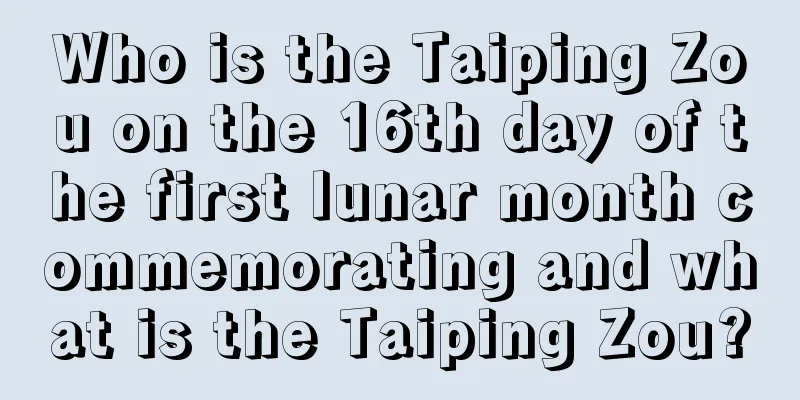Who is the Taiping Zou on the 16th day of the first lunar month commemorating and what is the Taiping Zou?

It is the 16th day of the first lunar month. The Han people have just celebrated the Lantern Festival and it is generally believed that the Lunar New Year is coming to an end. However, in some places in my country, there are still many customs and activities on the 16th day of the first lunar month. The Fortune Teller website provides you with more content related to the first lunar month of 2018. Everyone is welcome to learn about it together!What does it mean to have peace on the 16th day of the first lunar month?Walking on the Taiping Bridge on the 16th day of the first lunar month is a traditional folk culture. In Quanjiao County, Chuzhou City, Anhui Province, the hometown of the great writer Wu Jingzi, there is a folk custom that has lasted from ancient times to the present: on the 16th day of the first lunar month every year, the streets of the city are deserted, and people from all over the country, old and young, go out to walk on the Taiping Bridge from early morning to late at night... The flow of people is like a tide, shoulder to shoulder, and it is quite spectacular. They set off fireworks, light firecrackers, and burn incense and candles, praying for good weather, turning misfortune into good fortune, eliminating disasters and diseases, and living in peace and safety. It expresses the local working people's good wishes to exorcise evil, avoid disasters, and pray for blessings.The origin of walking in peace:This folk custom is called "Walking Taiping on the 16th day of the first lunar month", which is a unique traditional custom of Quanjiao and also the earliest and longest-standing fitness walking activity in Chinese history. It started in the Eastern Han Dynasty and has continued to flourish till today. "Book of Han" records the proverb "Chengri Taiping", which is the origin of Quanjiao's Taiping. The "Jingchu Sui Shi Ji" by Zong Yan of the Northern and Southern Dynasties specifically described the custom of walking across Taiping Bridge in the first month of the lunar year, calling it "walking away all diseases". As "qiao" is homophonic to "qiao", walking across the bridge means "looking at diseases" in order to ward off disasters and get rid of diseases. This custom has always been shared by the southern regions south of the Huai River. Why does Quanjiao alone have this custom while others have lost it? The tradition of Quanjiao's Taiping is passed down continuously and is related to three historical figures. At the beginning of the inheritance, the commemoration of the upright official Liu Ping was added, which has the meaning of refreshing rain and spreading sweet dew, making the custom of "Walking in Peace" more profound than other regions. Liu Ping, a native of Pengcheng, Chu, with the courtesy name Gongzi, was appointed the mayor of Quanjiao during the Jianwu period of the Eastern Han Dynasty. Officials are honest and upright, there are no prisoners in the jails, the people are content to do their jobs, and some pay more taxes than others pay less for their labor service. Wherever Dehua goes, tigers all cross the river to the west. According to the folk legend in Quanjiao, there was a great famine one year, and Liu Ping used the funds allocated by the court to build a city 30 miles in area for disaster relief, and used the remaining money to only build a small city of 3 miles in area. This is the "streets surrounding the city" phenomenon in the old city of Quanjiao (generally, cities are built with walls surrounding streets, but Quanjiao's streets surround the county government office). Liu Ping was dismissed from office and taken to the capital. When the people heard the news, they all came to see him off to a small bridge in the east of the city. That day happened to be the 16th day of the first lunar month, and the people all burned incense and bamboo, prayed and wished for the deceased, with their voices reaching all the way to the sky. According to the "Book of Han", Liu Ping resigned due to illness. Thanks to the prayers of the people of Quanjiao, Liu Ping miraculously recovered. He then went to the capital to serve as Shizhong and Zongzheng, and was listed among the Nine Ministers, and his name went down in history.The Taiping tradition was passed down to the Sui and Tang dynasties, but was almost lost due to the wars between the North and the South. Quanjiao also became famous for commemorating He Ruobi, a great general who founded the Sui Dynasty. According to the "Quanjiao County Chronicles" of the ninth year of the Republic of China, Taiping Bridge is also known as Helu Bridge. When the Sui general He Ruobi attacked Chen, he built a bridge here. When people recall the honest officials, they also add the element of protecting the country and the people. By the end of the Yuan Dynasty, the “Zou Taiping” in Quanjiao, like the “Zou Taiping” in other places, was almost extinct. At this time, the third historical figure, Chen Ying, was added to the tradition, giving it new life. According to the "Quanjiao County Chronicles" of the Kangxi period: In the early years of the Yongle period of the Ming Dynasty, a sorcerer suggested that if the Bifeng Mountain in Quanjiao City was raised, more candidates would be produced. The teacher Wu Ying led a group of scholars to the place to cultivate the soil. It happened that a general flag officer passed by and had an argument with the scholar, in which he was humiliated. Because the general flag officer was from Hunan, he could not pronounce the word "jiuzhu" (promoter) correctly. So he went to Nanjing and falsely accused the people of Quanjiao of wanting to cultivate a "zhu (juzi)" and committing treason. Emperor Yongle wanted to massacre Quanjiao. The Chief Censor Chen Ying was a native of Chuzhou. Upon hearing this, he reported: The people of Jiao are honest and kind, and will never rebel. He was willing to guarantee it with his own life. Thus, Quanjiao was cleared of all injustice. After Chen Ying died, the people of Jiao buried his clothes and hat on a high ridge at Taiping Bridge. Going to Taiping also adds the element of fellow villagers' friendship of blessing fellow villagers and helping those in need. So far, Quanjiao's "Walking for Peace" has added many contents to the traditional fitness walking, such as bringing gentle breeze and rain, protecting the country and the people, and making the place safe, blessing the folks, and helping the distressed, thus completing the sublimation of folk customs. Quanjiao County has a traditional walking route for “Peaceful Walking Tour on the 16th Day of the First Lunar Month”, namely Three Bridges and Two Streets. Enter Yuanjiawan Old Street from Jiyu Bridge (built in the Han Dynasty), cross Honglan Bridge (built in the Song Dynasty), walk to Taiping Street, and finally reach Taiping Bridge. This route has profound folk significance. Walking along three bridges, the “玉” (jade) from Jiyu, the “栏” (lan) from Honglan, and the “平” (ping) from Taiping, which is homophonic to “遇南平” (peaceful and peaceful), meaning all disasters and difficulties can be overcome; walking along two streets, the “元” (yuan) from Yuanjiawan and the “平” (ping) from Taiping Street, which is homophonic to “团团圆圆” and “平平安” (peaceful and peaceful). This traditional route is about five li long, with three bridges, each one higher than the last. As you walk up and down, you will feel calm and at ease. Your physiological functions will be orderly and regulated, making this a very suitable mileage for fitness. |
Recommend
What does "If it doesn't rain at the beginning of summer, the plows and harrows will have to be hung upside down" mean? What proverbs are there about the Beginning of Summer?
The arrival of the Beginning of Summer officially ...
Is the fifth day of the seventh lunar month in 2017 a suitable date for opening a new store?
Introduction: Although life is not easy for many p...
What day of the week is the 2018 Chinese New Year? How to arrange the 2018 Spring Festival holiday?
Introduction: The Spring Festival is not only an i...
Is it okay to set up the bed the day before the Lower Yuan Festival on October 14, 2019 in the lunar calendar? What date is the Lower Yuan Festival?
Introduction: Generally, you need to choose an aus...
What time is the Winter Solstice in 2018? What traditional food do we eat during the Winter Solstice?
Introduction: The Winter Solstice is an important ...
Is it possible to sail on the eighth day of the twelfth lunar month in 2019? What is the weather like on that day?
We know that there are many professions in the wor...
Is it a good time to open a new store during the winter solstice in 2019? In which month does the 39th day of the coldest period of winter fall in 2020?
Introduction: It is generally necessary to choose ...
What is the date of September 27th in the lunar calendar in 2017? Is it a good day for burial?
Introduction: Birth is a major event for everyone,...
Is it good for people born in the Year of the Ox during the Qingming Festival? A detailed analysis of their fate
Qingming Festival is a traditional Chinese festiva...
When does the Dragon Boat Festival holiday start in 2021? Will highways be free during the Dragon Boat Festival holiday in 2021?
The aroma of rice dumplings and the sound of laugh...
Where is the God of Happiness on the first day of the first lunar month in 2021? Red envelopes are distributed on the first day of the Chinese New Year.
Introduction: The auspicious position of the God o...
Is the fate of a baby chicken born on the third day of the ninth lunar month in 2017 good or bad?
Introduction: The ninth month of the lunar calenda...
Is it a good idea to pick up a new car on the 12th day of the fourth lunar month in 2018?
The fireworks of March have passed, and the most ...
Is it appropriate to hold a funeral on the second day of October in the year of Renyin in 2022? Is it a suitable auspicious day?
Is it appropriate to hold a funeral on the second ...
Is it a good idea to move to a new house on the 29th day of the first lunar month in 2018?
What day is the 29th day of the first lunar month...









